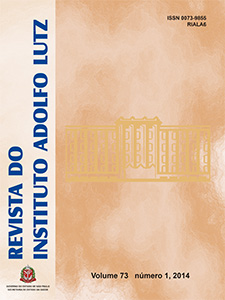Abstract
The rodents Proechimys guyannensis have led a great interest because they are considered as hosts to several pathogens causing zoological diseases. Therefore, it is important to know their biological and physiological parameters. The age at first cubs delivery and the average of birth interval per female were evaluated. The estimated age at puberty was 83 days. The number of pups born per delivery did not differ significantly when associated with the female mating age. However, an increase in the average mortality rate correlated with the increase in delivery number per female was detected. There is no statistical difference neither in the litter size in different seasons of the year, nor in the body weight between sexes for all ages. Differences were found in the daily water consumption and in the feed intake in animals with approximately 100 days of age, perhaps owing to the increased need for energy intake due to sexual activity or even because they had not reached adult weight yet. The parameters assessed in the present study are of relevance for maintaining this species in captivity as a laboratory animal.References
1. Pinto CM, Ocaña-Mayorga S, Lascano MS, Grijalva MJ. Infection by trypanosomes in marsupials and rodents associated with human dwellings in Ecuador. J Parasitol.2006;92(6):1251-5.
2. Rosa ES, Mills JN, Padula PJ, Elkhoury MR, Ksiazek TG, Mendes WS, et al. Newly recognized hantaviruses associated with hantavirus pulmonary syndrome in northern Brazil: partial genetic characterization of viruses and serologic implication of likelyreservoirs. Vector Borne Zoon Dis.2005;5(1):11-9.
3. Carrara AS, Gonzales G, Ferro C, Tamayo M, Aronson J, Paessler S, et al. Venezuelan equine encephalitis virus infection of spiny rats. Emerg Infect Dis.2005;11(5):663-9.
4. Dedet JP, Gay F, Chatenay G. Isolation of Leishmania species from wild mammals in French 220 Guiana. Trans R Soc Trop Med Hyg.1989;83:613-5.
5. Lainson R, Ishikawa EA, Silveira FT. American visceral leishmaniasis: wild animal hosts. Trans R Soc Trop Med Hyg.2002;96:630-41.
6. Carvalho RA, Arida RM, Cavalheiro EA. Amygdala kindling in Proechimys guyannensis rat: an animal model of resistance to epilepsy. Epilepsia.2003;44:165-70.
7. Arida RM, Scorza FA, Carvalho RA, Cavalheiro EA. Long-term consequences of intra hippocampal kainate injection in the Proechimys guyannensis rodent. Epilepsy Res.2005;65:201-10.
8. Andrioli A, Fabene PF, Spreafico R, Cavalheiro EA, Bentivoglio M. Different patterns of neuronal activation and neurodegeneration in the thalamus and cortex of epilepsy-resistant Proechimys rats versus Wistar rats after pilocarpine-induced protracted seizures. Epilepsia.2009;50:832-48.
9. Ribeiro NAB, Soares MCP, Pieczarka JC, Nagamachi CY. Identification of a long-stading colony of Proechimys at Instituto Evandro Chagas, Pará, Brazil, based on cytogenetic information. Rev Pan-Amaz Saúde.2011;2(1): 59-66.10.
10. Silva CEF, Eler ES, Silva MNF, Feldberg E. Karyological analysis of Proechimys cuvieri and Proechimys guyannensis (Rodentia, Echimyidae) from central Amazon. Genet Mol Biol. 2012;35(1):88-94. http://dx.doi.org/10.1590/S1415-47572012005000007.
11. Weir BJ. Another hystricomorph rodent: keeping casiragua (Proechimys guairae) in captivity. Lab Anim.1973;7:125-34.
12. Kaminsky P, Deibener J, Lesesve JF, Humbert JC. Changes in hemogram parameters in infections. Rev Med Int.2002; 23(2): 132-6.

This work is licensed under a Creative Commons Attribution 4.0 International License.
Copyright (c) 2015 Instituto Adolfo Lutz Journal
